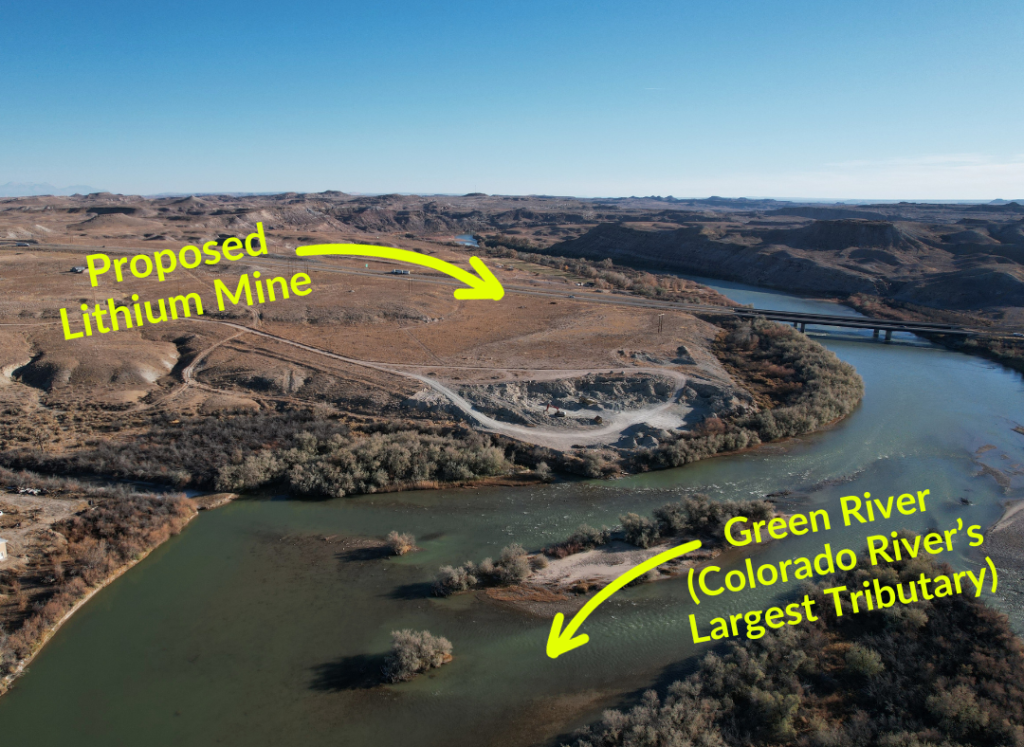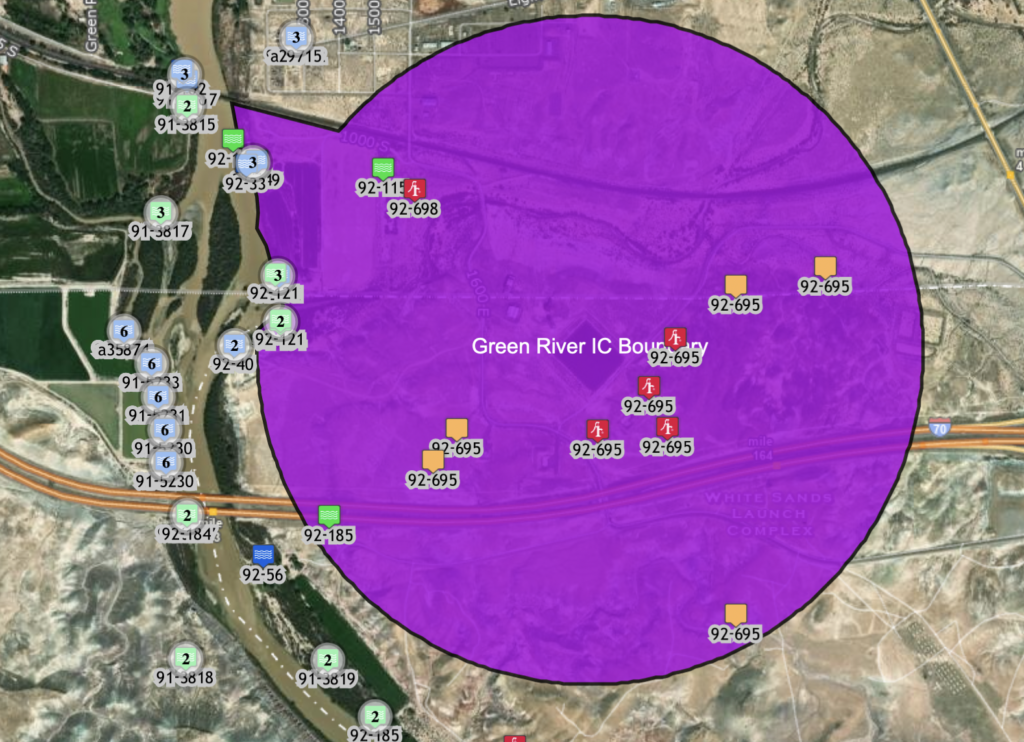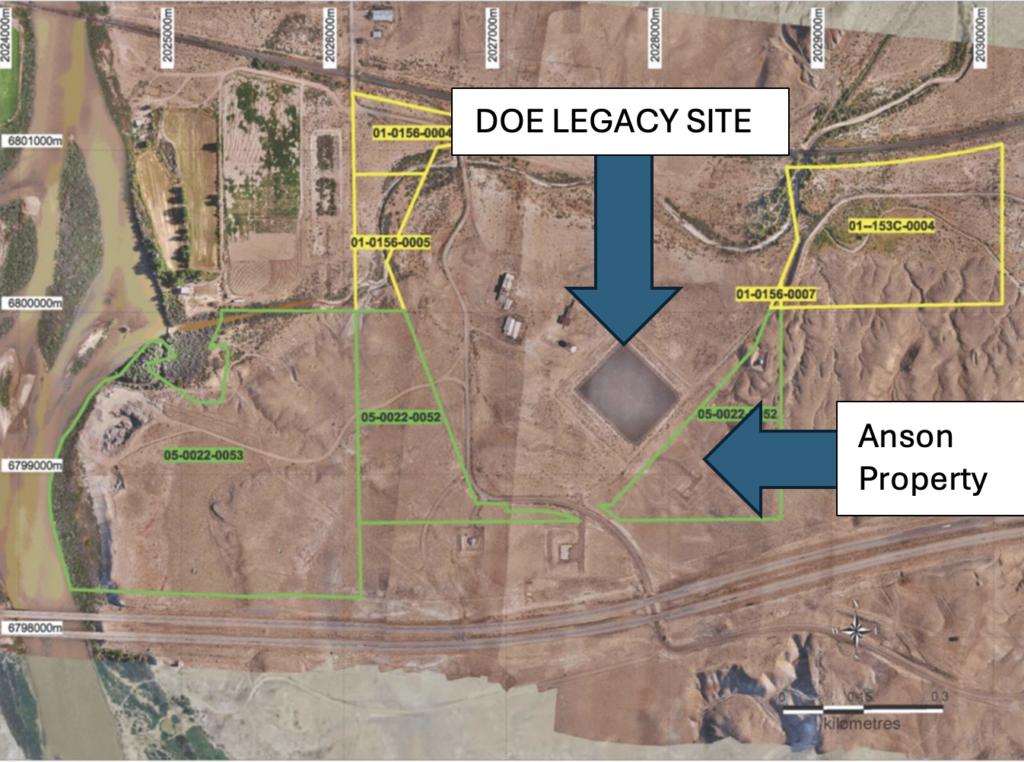
A recent approval from the Utah State Engineer raises questions about permitting a mine near a radioactive site with contaminated groundwater.
Utah’s love of lithium will not be foiled by a radioactive waste site.
The Utah State Engineer approved water rights for a major lithium mine on the banks of the Green River on a site that sits within the boundaries of a state-approved Area of Concern, setting a questionable precedent for deep drilling operations in hydro-geologically sensitive areas with known histories of radioactive contamination.
On May 1, the State Engineer issued a relatively short ruling to give the project the green light, issuing a nearly 14,000-acre-feet permit for non-consumptive water rights to Blackstone Minerals for lithium brine operations. The decision eludes major questions regarding deep pumping near a radioactive site and fails to address major communication failures between Utah, the federal government, and the concerned public. The decision downplays potential connectivity with the Colorado River system, relying on a 42-year-old study, and sets a standard for applicants that want to access water that is thousands of feet below the ground. Lastly, it also raises questions about how regulators will treat so-called non-consumptive applications. The notion of non-consumptive water usage, for many hydrologists, is an impossible one.
The decision follows a near 10-month saga in the region. Blackstone’s parent company, Anson Resources, was filing water rights applications throughout the region near the banks of the Green and the Colorado Rivers last year, prompting GBWN and its rural allies to review and protest those efforts in the regulatory arena.
For now, it appears we have stalled the efforts on the Colorado River. But many questions remain as our coalition considers its next steps on how to demand accountability for the project moving forward on the Green River.
THE LITHIUM MINE AND THE AREA OF CONCERN
All within a half-mile radius of the Green River and its eponymous town, there is a tension about industry, past and present.
Big lithium mining plans, and a Department of Energy Legacy Management site — a former uranium mill that remains radioactive — sit near Green River residential lots and agricultural operations, and the waterway.
The State Engineer’s decision caps a major effort by Blackstone Minerals-Anson Resources to buy land, secure water, and stack permits. While the effort is not complete, the water rights were a major barrier for the company.
The company, and now the state, believe that the operation won’t be a problem.
However, after combing through documents from the Department of Energy and the Nuclear Regulatory Commission, our coalition has considerable concerns about whether extracting lithium brine from this site is worth the risk.
The radioactive legacy of the site is one of many examples across the west challenging us to ask hard questions about our transition away from fossil fuels. And, no matter what happens, there needs to be open and honest dialogue about how past mining operations will affect the future for families, businesses, and ecosystems that all live mere feet from Anson’s proposal.
WHAT OUR COALITION OF FARMERS, ACTIVISTS AND CONCERNED CITIZENS HAS FOUND:
- Anson’s wells will drill through a contaminated aquifer, raising questions about the public welfare and possibility of greater groundwater pollution over the course of time.
- Anson’s wells exist inside the boundaries of an Area of Concern (AOC) that the State of Utah approved as part of a 2011 Groundwater Containment Action Plan (GCAP).
- Federal officials raised concerns that the GCAP could be inadequate, according to records unearthed by our coalition. Federal regulators described the plan as not “durable and enforceable.”
- Federal and state regulators were supposed to have filed water rights protests, according to the Draft GCAP, but that never happened.
- The State of Utah and the federal nuclear waste regulators did not consult until months after the water rights applications were filed, exposing a major hole in the existing groundwater protection framework. Now the contents of their conversations are happening behind closed doors, not at public meetings.
- Levels of groundwater contamination at the site are not decreasing. Federal officials expressed concern in recent years about the potential spread of radioactivity.


MORE TO COME: HOW WILL REGULATORS RESPOND TO COMMUNITY MEMBERS
As Wednesday’s decision was coming down from the State Engineer, GBWN and its coalition sent a letter to state and federal regulators demanding answers about the legacy management issues.
This followed a blowout during Anson’s exploratory drilling at the Blackstone site — something that we warned of when we first saw the project. The geology of the region is highly pressurized with gases. And, as Anson was drilling test wells, the high pressure geology sent water gushing all over Anson’s job site and upended Anson’s exploratory drilling efforts.
We have also raised concerns for months about the nature of the application to appropriate 14,000 acre-feet of water in the region. However, the company says that there won’t be any losses. In other words, what the company pumps, it will reinject. The mineral will be extracted, via a process known as Direct Lithium Extraction, and then the water will be reinjected.
The notion of “zero” consumptive use for a major extraction project like is simply not true. Many scientists say that there’s no such thing as “zero” consumptive use. But regulators will have broad discretion to support an application in relation to its connectivity with the river and other groundwater — especially those radioactive groundwater.
This isn’t about lithium. This is about protecting the public welfare.
We are demanding more accountability from regulators at the site, which saddles both Grand and Emery County in Utah. Please sign the petition to help raise awareness and demand that we have the best standards for our communities and natural resources.
Thank you.
Kyle
